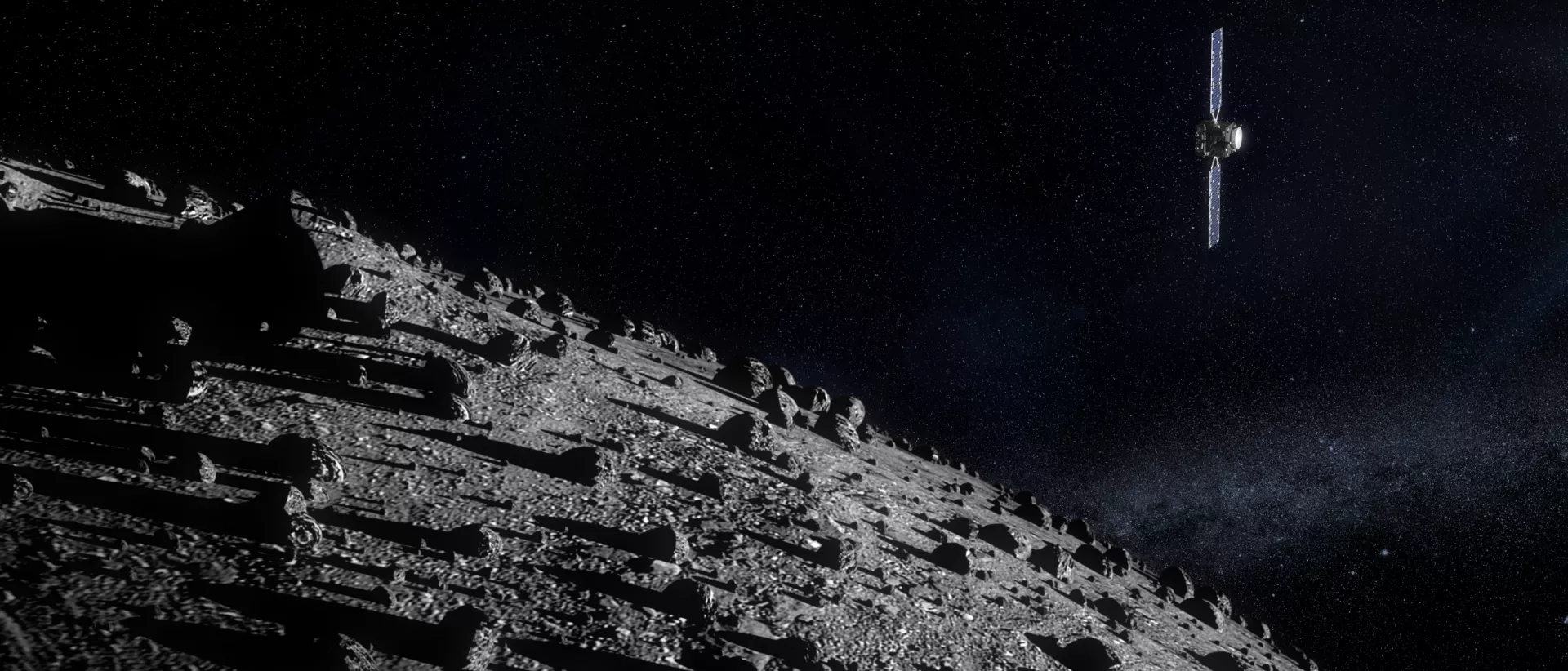
03.10.2024
Europe’s Hera asteroid mission relies on Beyond Gravity technology
Beyond Gravity, a leading supplier to the space industry, provided key products for Europe’s first-ever planetary defense mission, Hera. The company provided the solar wings of the spacecraft, its central tube (backbone) and electronic products.
The European Space Agency’s Hera planetary defense mission is expected to launch between 7 and 27 October 2024 from Cape Canaveral in the USA aboard a SpaceX Falcon 9 rocket. The spacecraft will fly to an asteroid that was hit two years ago by NASA’s DART spacecraft, the world’s first deflection of an asteroid. The Hera spacecraft will investigate in detail the effect of the DART impact on the asteroid with the help of various cameras and scientific instruments. “Changing an asteroid’s trajectory is an important planetary defense technique for humanity if a large asteroid is ever found to be on a collision course with Earth. We provided important components to this mission. Our solar wings make sure that Hera always receives enough electrical power for its operations, and our central tube acts as the backbone of the spacecraft”, says Oliver Grassmann, Executive Vice President Satellites, at Beyond Gravity, a leading European supplier for both established companies and New Space. The prime contractor of Hera is the German satellite manufacturer OHB in Bremen.
Solar wings for Hera
For the van-sized Hera spacecraft, Beyond Gravity provided two 5-meter-long solar wings. Each solar wing consists of three hinged panels. This gives a total area of about 14 square meters. Oliver Grassmann: “It’s the first time Beyond Gravity developed the complete solar arrays for a European space mission.” Beyond Gravity also delivered the mechanisms that point the solar arrays toward the Sun. The spacecraft and its solar arrays will operate at temperatures between -100°C and +140°C. The solar panels will continue working even with Hera at its furthest distance from the Sun, out beyond Mars orbit, where the spacecraft will receive only 17% of the sunlight compared to a satellite orbiting Earth. In the phases of the mission in which Hera will be most distant, the solar panels will generate around 800 watts, equal to the energy needed to power a small microwave oven. The solar arrays will generate enough energy to power the spacecraft’s onboard computer, navigational cameras and communications antenna.
Backbone of the Hera spacecraft
Beyond Gravity also provided the central structure for the Hera satellite. Made of carbon fibre reinforced polymer, this is the central core on which all other components are mounted. The stiff, strong central tube is the main structural element of the spacecraft, keeping everything together. The function of the central tube can be compared with a chassis of a car. The central cylinder is the central part of the spacecraft, interfacing with the launcher during launch and holding together the spacecraft components such as the propellant tanks, thrusters, and decks hosting all of the spacecraft equipment.
About Hera
The European Hera spacecraft follows a history-making NASA mission. In September 2022, the NASA spacecraft DART impacted the Dimorphos asteroid, successfully diverting its course – humankind’s first planetary defense test. After launch in October 2024, the Hera spacecraft will arrive two years later at the asteroid system to investigate the post-impact asteroid. The asteroid is about 181 million kilometers away from Earth.
Hera will investigate the altered nature of Dimorphos due to NASA’s DART spacecraft impacting it and shifting its orbit in September 2022. The data returned by Hera will turn this ‘kinetic impact’ method into a well-understood and potentially repeatable planetary defense method.
Hera is also the first mission to carry cubesats to asteroids in deep space. Hera will not only collect insights on how to deflect an asteroid on the way to hit Earth, it will also unveil secrets of the formation of the solar system.
Hera spacecraft dimensions
The spacecraft’s cube-shaped body measures 1.6 m across per side, plus solar arrays that stretch 11.5 m when fully deployed. Hera is roughly the size of a small car and weighs about 1150 kg fully fueled. The satellite is powered by solar arrays and a hydrazine propulsion system.
Image and video material for use at your own discretion:
Image 1: Beyond Gravity provided the two solar wings of the Hera spacecraft, Europe’s first planetary defense mission. © ESA-SJM Photography. Download:
Image 2: A central tube from Beyond Gravity, made of carbon fibre reinforced polymer, acts as the backbone of the Hera spacecraft. © Beyond Gravity. Download:
Image 3: Hera solar wing from Beyond Gravity during testing at an ESA cleanroom in the Netherlands. © ESA-SJM Photography. Download:
Image 4: The Hera spacecraft will investigate in detail the effect of the DART impact on Dimorphos with the help of various cameras and scientific instruments. © ESA
Image 5: Hera spacecraft approaching the target asteroid. © ESA
More about the mission: www.esa.int/hera
Media Kit from ESA about Hera (September 2024):
Media release from OHB: https://www.ohb.de/en/news/ohb-technology-to-protect-our-planet-asteroid-probe-hera-is-fit-for-space
Animation of Hera approaching the asteroids © ESA
Video: Learn how Beyond Gravity is pushing boundaries of what is technically feasible for the benefit of humankind. © Beyond Gravity

